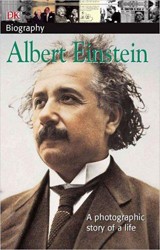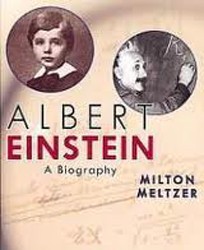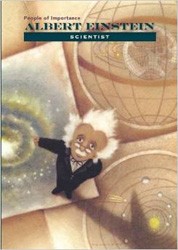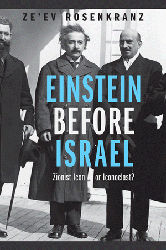One hundred years ago, in 1905, an unknown 26-year-old technical expert in the Swiss Patent Office published four groundbreaking articles in a leading physics journal. One of these articles contained what has become the world’s most famous equation, E=mc2, also known as the theory of relativity. This theory, along with the others he published that year, propelled Albert Einstein into the spotlight and revolutionized science. In a market saturated with biographies of this famous scientist, where should readers begin? Delano’s biography stands out as a stellar choice. The popular trend in today’s juvenile nonfiction is to replicate for young readers the experience of surfing the Internet or playing a video game; many books are filled with sidebars, links to web pages, and cartoon characters which pop up on the page to point out useful information. Delano’s book is a refreshing change. Using a straightforward style and plenty of attractive photos, along with easy-to-understand diagrams of difficult scientific concepts, Genius provides a wonderfully complete biography of Einstein. Black-and-white and sepia-toned photos are smoothly displayed against backgrounds showing letters and texts written in Einstein’s own hand, as well as other important manuscripts such as his U.S. naturalization certificate. The text itself takes the reader swiftly through Einstein’s life, from birth to death, with enough details to give a well-rounded portrait of the man Time magazine named “Person of the Century.”
Einstein was a scientist first and foremost, but he was also a Jew. Delano does a fine job explaining how his religion and ancestry helped shape Einstein as more than a genius. He spoke out against Hitler and, despite his antiwar stance, advocated fighting the Nazis. From his home in Princeton, New Jersey, Einstein worked to help settle Jews and other refugees who had left Europe to escape persecution. Einstein was also a Zionist; after the death of Chaim Weizmann in 1952, Einstein was offered the presidency of Israel, which he reluctantly turned down. Delano’s excellent biography is rounded out by a one page chronology, as well as a list of resources consisting of books, recent newspaper articles, a video, and web sites (with links that are current as of this writing). A detailed index lists everything from Atomic bombs to Zionism. This gem from the National Geographic Society should be on the shelves of every public, school, and synagogue library. For ages 10 – 12.





